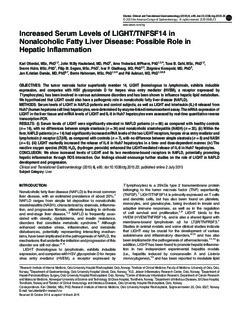| dc.contributor.author | Otterdal, Kari | |
| dc.contributor.author | Haukeland, John Willy | |
| dc.contributor.author | Yndestad, Arne | |
| dc.contributor.author | Dahl, Tuva Børresdatter | |
| dc.contributor.author | Holm, Sverre | |
| dc.contributor.author | Segers, Filip | |
| dc.contributor.author | Gladhaug, Ivar Prydz | |
| dc.contributor.author | Zbigniew, Konopski | |
| dc.contributor.author | Damås, Jan Kristian | |
| dc.contributor.author | Halvorsen, Bente | |
| dc.contributor.author | Aukrust, Pål | |
| dc.date.accessioned | 2018-01-02T11:43:01Z | |
| dc.date.available | 2018-01-02T11:43:01Z | |
| dc.date.created | 2015-11-21T14:49:15Z | |
| dc.date.issued | 2015 | |
| dc.identifier.issn | 2155-384X | |
| dc.identifier.uri | http://hdl.handle.net/11250/2473998 | |
| dc.description.abstract | Objectives:
The tumor necrosis factor superfamily member 14, LIGHT (homologous to lymphotoxin, exhibits inducible expression, and competes with HSV glycoprotein D for herpes virus entry mediator (HVEM), a receptor expressed by T lymphocytes), has been involved in various autoimmune disorders and has been shown to influence hepatic lipid metabolism. We hypothesized that LIGHT could also have a pathogenic role in nonalcoholic fatty liver disease (NAFLD).
Methods:
Serum levels of LIGHT in NAFLD patients and control subjects, as well as LIGHT and interleukin (IL)-8 released from Huh7 (human hepatoma cell line) hepatocytes, were determined by enzyme-linked immunosorbent assay. The mRNA expression of LIGHT in the liver tissue and mRNA levels of LIGHT and IL-8 in Huh7 hepatocytes were assessed by real-time quantitative reverse transcription-PCR.
Results:
(i) Serum levels of LIGHT were significantly elevated in NAFLD patients (n=66) as compared with healthy controls (n=16), with no differences between simple steatosis (n=34) and nonalcoholic steatohepatitis (NASH) (n=32). (ii) Within the liver, NAFLD patients (n=14) had significantly increased mRNA levels of the two LIGHT receptors, herpes virus entry mediator and lymphotoxin β receptor (LTβR), as compared with controls (n=7), with no difference between simple steatosis (n=8) and NASH (n=6). (iii) LIGHT markedly increased the release of IL-8 in Huh7 hepatocytes in a time- and dose-dependent manner. (iv) The reactive oxygen species (ROS) H2O2 (hydrogen peroxide) enhanced the LIGHT-mediated release of IL-8 in Huh7 hepatocytes.
Conclusion:
We show increased levels of LIGHT and its two membrane-bound receptors in NAFLD, potentially promoting hepatic inflammation through ROS interaction. Our findings should encourage further studies on the role of LIGHT in NAFLD development and progression. | nb_NO |
| dc.language.iso | eng | nb_NO |
| dc.publisher | Nature Publishing Group | nb_NO |
| dc.rights | Attribution-NonCommercial-NoDerivatives 4.0 Internasjonal | * |
| dc.rights.uri | http://creativecommons.org/licenses/by-nc-nd/4.0/deed.no | * |
| dc.title | Increased serum levels of LIGHT/TNFSF14 in nonalcoholic fatty liver disease: Possible role in hepatic inflammation | nb_NO |
| dc.type | Journal article | nb_NO |
| dc.type | Peer reviewed | nb_NO |
| dc.description.version | publishedVersion | nb_NO |
| dc.source.volume | 6:e95 | nb_NO |
| dc.source.journal | Clinical and Translational Gastroenterology | nb_NO |
| dc.identifier.doi | 10.1038/ctg.2015.23 | |
| dc.identifier.cristin | 1291686 | |
| dc.relation.project | Norges forskningsråd: 223255 | nb_NO |
| dc.description.localcode | © 2015 the American College of Gastroenterology All rights reserved. This work is licensed under a Creative Commons Attribution-NonCommercial-NoDerivs 4.0 International License. | nb_NO |
| cristin.unitcode | 194,65,15,0 | |
| cristin.unitname | Institutt for klinisk og molekylær medisin | |
| cristin.ispublished | true | |
| cristin.fulltext | original | |
| cristin.qualitycode | 1 | |

